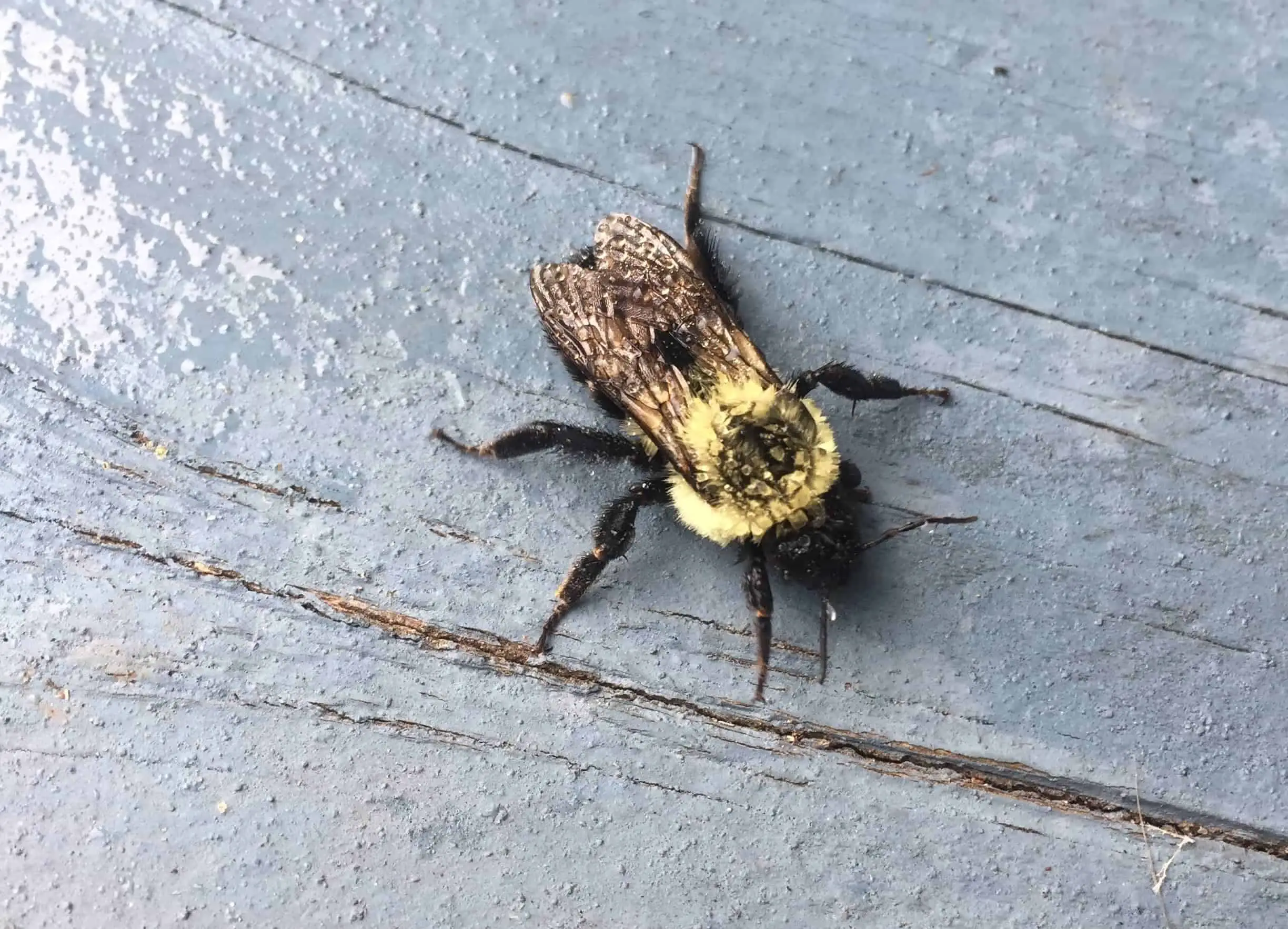Carpenter Bees are a wood destroying insect, their behavior is not like any other bee.
So the big question is:
Will carpenter bees damage my home? Yes. If it is left untreated, new Carpenter Bees will come back to the same holes that the prior seasoned bees inhabited year after year expanding them and making new holes near the old ones.
So over the course of many years, the holes can cause enough compromising damage to the wood of your home. Not to mention the way they make your home look aesthetically.
Description:
Carpenter Bees have a waxy mostly solid black abdomen (rear end) not to be confused with a bumble bees abdomen which is fuzzy, yellow and black in color.
This is the best way to distinguish the difference between the two. The male Carpenter bee has a white face where the female’s face is black.
Will Carpenter Bees Sting Me?
Well, yes. The female carpenter bee can sting you, but the chances are very small. You would really have to mess with her or try to handle her in your hands for her to sting you.
Another reason the chances are low is since carpenter bees are anti-social you will hardly ever see the female as she only goes out to collect pollen and nectar for her larvae to eat.
The males don’t contain a stinger which means only the female can sting you which lowers your chances of getting stung since most Carpenter Bees you see are male.
The males will fly aggressively if they are protecting something or if you get too close to their nest.
Will Carpenter Bees Bite?
Carpenter bees do not bite, the only thing a female carpenter bee will bite is wood, and this is done to tunnel her nest.
Do Carpenter Bees Eat Wood?
No, however, the female Carpenter Bee will tunnel into wood using her teeth to chew it, turning it into rough sawdust, this is how she makes her nest. Each year female carpenter bees will make their nest in the same area as the previous season they will use old holes and bore new ones to lay their eggs.
Will Carpenter Bees Bore Into Cedar?
These bees will chew through most woods, in fact, Carpenter Bees will go after Redwood, Cypress, and even Cedar despite their pest repelling abilities.
Untreated woods are most vulnerable but even stained, and painted wood can be a target for these pesky girls.
Do Carpenter Bees Pollinate?
Yes, Carpenter Bees are vital pollinators. Carpenter bees help gardens, and farm crops in some areas. In some places, Carpenter Bees are one of the only sources of pollination.
Do Carpenter Bees Hibernate?
Not all carpenter bees will make it to the next season, the ones that do will hibernate individually since they do not colonize like traditional bees. Carpenter Bees will overwinter until spring in old nest tubes, living off of the last bit of nectar collected in the late season.
When Is The Best Time To Kill Carpenter Bees?
The best time to kill Carpenter Bees is before the female finishes tunneling. Since it is not always easy to see when your home or buildings may be under attack from carpenter bee damage there is another way even if you have a full-blown infestation. Wait till night time when they are all sleeping in the tunnels and either spray or dust them then.
What Kills Carpenter Bees?
This is a great question, and the answer is lots of things.
These Chemicals Work Well With An Immediate Knockdown:
Cyfluthrin- I’ve found when using cyfluthrin it is best to purchase it in dust form and use a bellows duster to apply it to the holes.
Lambda-Cyhalothrin – If you decide to use this in an aerosol form it is best to get a can that has a straw attachment. If you get it in liquid form you will need to mix it in a spray can with water.
Bifenthrin – This comes in a liquid form and should be mixed in a spray can and diluted with water.
All of these options will work immediately for the knockdown and eradication of Carpenter Bees.
Some chemicals will wear off and if new Carpenter Bees become present after 3-4 weeks of the initial treatment re-application may be necessary to finish the job.
Directions Of Use: When using dust you will want to purchase a bellows duster to apply it, do not attempt to apply dust directly from the container it comes in, you will make a mess and it is not fun to clean up.
When using a liquid you will need a spray can and water. Simply mix the amount of chemical that the label tells you to with a single gallon of water. Do not add extra as it is not necessary they made this stuff strong enough to do the job.
Protective Gear:
Make Sure To Wear These Items With All Treatments:
- Glasses/Goggles
- Gloves
- Long Sleeve Shirt
- Closed Toe Shoes
- Long Pants
Caution: Some of the items mentioned in this post may not be lawful to use in your state or country. If you are unsure please be proactive in finding out by contacting your local department of agriculture.
Warning: It is a violation of Federal Law to use a pesticide in any way that is not consistent with it’s labeling.
How Do I Keep Carpenter Bees From Coming Back Next Year?
After you have eradicated the bees it is best to seal off all the holes you can get to, this can be done a number of ways. You can use wood glue with dowels, silicone, and wood putty, these are all acceptable ways to seal off the holes. The chemical in the holes will keep them from wanting to come back.
Why Is Sealing The Holes Important?
Sealing the old Carpenter Bee hives off will help keep them away next season. Sealing off the holes will also help the wood maintain it’s strength it also helps to avoid moisture and other pest and from inhabiting the holes and creating more problems that your home doesn’t need.
Summary
Carpenter Bees can damage your home if left neglected for years. Be proactive in protecting your most valuable asset by treating and sealing the holes. If you don’t want to handle this problem yourself you can always get help from the pros.
Also if you want to see what products I use to take care of carpenter bees click this link below to see all the things we talked about here
.

